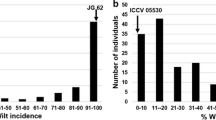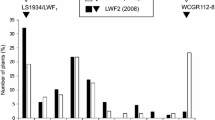Abstract
Fusarium oxysporum f. sp. melonis (FOM) causes serious economic losses in melon (Cucumis melo L.). Two dominant resistance genes have been identified, Fom-1 and Fom-2, which provide resistance to races 0 and 2 and races 0 and 1, respectively, however FOM race 1.2 overcomes these resistance genes. A partial resistance to FOM race 1.2 that has been found in some Far East accessions is under polygenic control. A genetic map of melon was constructed to tag FOM race 1.2 resistance with DNA markers on a recombinant inbred line population derived from a cross between resistant (Isabelle) and susceptible (cv. Védrantais) lines. Artificial root inoculations on plantlets of this population using two strains, one that causes wilting (FOM 1.2w) and one that causes yellowing (FOM 1.2y), resulted in phenotypic and genotypic data that enabled the identification of nine quantitative trait loci (QTLs). These QTLs were detected on five linkage groups by composite interval mapping and explained between 41.9% and 66.4% of the total variation. Four digenic epistatic interactions involving seven loci were detected and increased the total phenotypic variation that was explained. Co-localizations between QTLs and resistance gene homologs or resistance genes, such as Fom-2 and Vat, were observed. A strain-specific QTL was detected, and some QTLs appeared to be recessive.


Similar content being viewed by others
References
Al-Chaarani GR, Roustaee A, Gentzbittel L, Mokrani L, Barrault G, Dechamp-Guillaume G, Sarrafi A (2002) A QTL analysis of sunflower partial resistance to downy mildew (Plasmopara halstedii) and black stem (Phoma macdonaldii) by the use of recombinant inbred lines (RILs). Theor Appl Genet 104:490–496
Arahana VS, Graef GL, Specht JE, Steadman JR, Eskridge KM (2001) Identification of QTLs for resistance to Sclerotinia sclerotiorum in soybean. Crop Sci 41:180–188
Arru L, Francia E, Pecchioni N (2003) Isolate-specific QTLs of resistance to leaf stripe (Pyrenophora graminea) in the ‘Septoe’ בMorex’ spring barley cross. Theor Appl Genet 106:668–675
Basten CJ, Weir BS, Zeng ZB (2003) qtl-cartographer, version 1.17. A reference manual and tutorial for QTL mapping. North Carolina State University, Raleigh, N.C.
Baudracco-Arnas S (1995) A simple and inexpensive method for DNA extraction from Cucumis melo L. Cucurbit Genet Coop Rep 18:50–51
Baudracco-Arnas S, Pitrat M (1996) A genetic map of melon (Cucumis melo L.) with RFLP, RAPD, isozyme, disease resistance and morphological markers. Theor Appl Genet 93:57–64
Brotman Y, Silberstein L, Kovalski I, Klingler J, Thompson G, Katzir N, Perl-Treves R (2000) Linkage groups of Cucumis melo, including resistance gene homologues and known genes. Acta Hortic 510:441–448
Brotman Y, Silberstein L, Kovalski I, Périn C, Dogimont C, Pitrat M, Klingler J, Thompson GA, Perl-Treves R (2002) Resistance genes homologues in melon are linked to genetic loci conferring disease and pest resistance. Theor Appl Genet 104:1055–1063
Caranta C, Lefebvre V, Palloix A (1997a) Polygenic resistance of pepper to potyviruses consists of a combination of isolate-specific and broad-spectrum quantitative trait loci. Mol Plant Microbe Interact 10:872–878
Caranta C, Palloix A, Lefebvre V, Daubeze AM (1997b) QTLs for a component of partial resistance to cucumber mosaic virus in pepper: restriction of virus installation in host-cells. Theor Appl Genet 94:431–438
Dahleen LS, Agrama HA, Horsley RD, Steffenson BJ, Schwarz PB, Mesfin A, Franckowiak JD (2004) Identification of QTLs associated with Fusarium head blight resistance in Zhedar 2 barley. Theor Appl Genet 108:95–104
Danin-Poleg Y, Reis N, Baudracco-Arnas S, Pitrat M, Staub JE, Oliver M, Arús P, de Vicente CM, Katzir N (2000) Simple Sequence Repeats in Cucumis mapping and map merging. Genome 43:963–974
Danin-Poleg Y, Reis N, Tzuri G, Katzir N (2001) Development and characterization of microsatellite markers in Cucumis. Theor Appl Genet 102:61–72
Danin-Poleg Y, Tadmor Y, Tzuri G, Reis N, Hirschberg J, Katzir N (2002) Construction of a genetic map of melon with molecular markers and horticultural traits, and localization of genes associated with ZYMV resistance. Euphytica 125:373–384
Dogimont C, Leconte L, Périn C, Thabuis A, Lecoq H, Pitrat M (2000) Identification of QTLs contributing to resistance to different strains of cucumber mosaic cucumovirus in melon. Acta Hortic 510:391–398
Fall AL, Byrne PF, Jung G, Coyne DP, Brick MA, Schwartz HF (2001) Detection and mapping of a major locus for fusarium wilt resistance in common bean. Crop Sci 41:1495–1498
Fischer BM, Salakhutdinov I, Akkurt M, Eibach R, Edwards KJ, Topfer R, Zyprian EM (2004) Quantitative trait locus analysis of fungal disease resistance factors on a molecular map of grapevine. Theor Appl Genet 108:501–515
Foulongne M, Pascal T, Pfeiffer F, Kervella J (2003) QTLs for powdery mildew resistance in peach ×Prunus davidiana crosses: consistency across generations and environments. Mol Breed 12:33–50
Garcia-Mas J, Leeuwen HV, Monfort A, Carmen de Vicente M, Puigdomenech P, Arus P (2001) Cloning and mapping of resistance gene homologues in melon. Plant Sci 161:165–172
Geiger HH, Heun M (1989) Genetics of quantitative resistance to fungal diseases. Phytopathology 27:317–341
Katzir N, Danin-Poleg Y, Tzuri G, Karchi Z, Lavi U, Cregan PB (1996) Length polymorphism and homologies of microsatellites in several Cucurbitaceae species. Theor Appl Genet 93:1282–1290
Kesseli R, Witsenboer H, Stanghellini M, Vandermark G, Michelmore R (1993) Recessive resistance to Plasmopara lactucae-radicis maps by bulked segregant analysis to a cluster of dominant disease resistance genes in lettuce. Mol Plant Microbe Interact 6:722–728
Kosambi DD (1944) The estimation of map distances from recombination values. Ann Eugen 12:172–175
Lander ES, Green P, Abrahamson J, Barlow J, Daly MJ, Lincoln SE, Newburg L (1987) mapmaker: an interactive computer package for constructing primary genetic linkage maps of experimental and natural populations. Genomics 1:174–181
Lefebvre V, Chèvre AM (1995) Tools for marking plant disease and pest resistance genes: a review. Agronomie 15:3–19
Lefebvre V, Palloix A (1996) Both epistatic and additive effects of QTLs involved in polygenic induced resistance to disease: a case study, the interaction pepper-Phytophthora capsici Leonian. Theor Appl Genet 93:503–511
Leonards-Schippers C, Gieffers W, Schäfer-Pregl R, Ritter E, Knapp SJ, Salamini F, Gebhardt C (1994) Quantitative resistance to Phytophthora infestans in potato: a case study for QTL mapping in an allogamous plant species. Genetics 137:67–77
Liao CY, Wu P, Hu B, Yi KK (2001) Effects of genetic background and environment on QTLs and epistasis for rice (Oryza sativa L.) panicle number. Theor Appl Genet 103:104–111
Liou PC, Chang YM, Hsu WS, Cheng YH, Chang HR, Hsiao CH (1998) Construction of a linkage map in Cucumis melo (L.) using random amplified polymorphic DNA markers. In: Proc Int Symp Biotechnol Trop Subtrop Species. Brisbane, Queensland, Australia, pp 123–131
Manzanares-Daulieux MJRD, Baron F, Thomas G (2000) Mapping of one major gene and of QTLs involved in resistance to clubroot in Brassica napus. Theor Appl Genet 101:885–891
Monforte AJ, Oliver M, Gonzalo MJ, Alvarez JM, Dolcet-Sanjuan R, Arus P (2003) Identification of quantitative trait loci involved in fruit quality traits in melon (Cucumis melo L.). Theor Appl Genet 108:750–758
Oliver JL, Garcia-Mas J, Cardús M, Pueyo N, López-Sesé AI, Arroyo M, Gómez-Paniagua H, Arús P, de Vicente CM (2001) Construction of a reference linkage map of melon. Genome 44:836–845
Parlevliet JE, Zadoks JC (1977) The integrated concept of disease resistance; a new view including horizontal and vertical resistance in plants. Euphytica 26:5–21
Perchepied L, Pitrat M (2004) Polygenic inheritance of partial resistance to Fusarium oxysporum f. sp. melonis race 1.2 in melon. Phytopathology 94:1331–1336
Périn C, Hagen LS, de Conto V, Katzir N, Danin-Poleg Y, Portnoy V, Baudracco-Arnas S, Chadoeuf J, Dogimont C, Pitrat M (2002) A reference map of Cucumis melo based on two recombinant inbred line populations. Theor Appl Genet 104:1017–1034
Pressoir G, Albar L, Ahmadi N, Rimbault I, Lorieux M, Fargette D, Ghesquière A (1998) Genetic basis and mapping of the resistance to rice yellow mottle virus. II. Evidence of a complementary epistasis between two QTLs. Theor Appl Genet 97:1155–1161
Qi X, Jiang G, Chen W, Niks RE, Stam P, Lindhout P (1999) Isolate-specific QTLs for partial resistance to Puccinia hordei in barley. Theor Appl Genet 99:877–884
Risser G, Mas P (1965) Mise en évidence de plusieurs races de Fusarium oxysporum f. sp. melonis. Ann Amelior Plant 15:405–408
Risser G, Rode JC (1973) Breeding for resistance to Fusarium oxysporum f. melonis. In: Eucarpia: La sélection du melon. Montfavet-Avignon, France, pp 37–39
Risser G, Banihashemi Z, Davis DW (1976) A proposed nomenclature of Fusarium oxysporum f. sp. melonis races and resistance genes in Cucumis melo. Phytopathology 66:1105–1106
Robertson DS (1985) A possible technique for isolating genic DNA for quantitative traits in plants. J Theor Biol 117:1–10
Robertson A (1989) Understanding the relationship between qualitative and quantitative genetics. In: Helentjaris T, Burr B (eds) Development and application of molecular markers to problems in plant genetics. Cold Spring Harbor Laboratory Press, New York, pp 81–88
Saghai-Maroof MA, Yue YG, Xiang ZX, Stromberg EL, Rufener GK (1996) Identification of quantitative trait loci controlling resistance to gray leaf spot disease in maize. Theor Appl Genet 93:539–546
Schnurbusch T, Paillard S, Fossati D, Messmer M, Schachermayr G, Winzeler M, Keller B (2003) Detection of QTLs for Stagonospora glume blotch resistance in Swiss winter wheat. Theor Appl Genet 107:1226–1234
Silberstein L, Kovalski I, Brotman Y, Périn C, Dogimont C, Pitrat M, Klingler J, Thompson G, Portnoy V, Katzir N, Perl-Treves R (2003) Linkage map of Cucumis melo including phenotypic traits and sequence-characterized genes. Genome 46:761–773
Talukder ZI, Tharreau D, Price AH (2004) Quantitative trait loci analysis suggests that partial resistance to rice blast is mostly determined by race-specific interactions. New Phytol 162:197–209
Wang GL, Ruan DL, Song WY, Sideris S, Chen LL, Pi LY, Zhang SP, Zhang Z, Fauquet C, Gaut BS, Whalen MC, Ronald PC (1998) Xa21D encodes a receptor-like molecule with a leucine-rich repeat domain that determines race-specific recognition and is subject to adaptative evolution. Plant Cell 10:765–779
Wang YH, Thomas CE, Dean RA (1997) A genetic map of melon (Cucumis melo L.) based on amplified fragment length polymorphism (AFLP) markers. Theor Appl Genet 95:791–797
Wang YH, Thomas CE, Dean R (2000) Genetic mapping of Fusarium wilt resistance gene Fom-2 in melon (Cucumis melo L.). Mol Breed 6:379–389
Zeng ZB (1994) Precision mapping of quantitative trait loci. Genetics 136:1457–1468
Acknowledgements
The authors thank Benoît Moury for his critical review of the manuscript. Laure Perchepied thanks the ASL, Clause-Tézier, Gautier, Rijk Zwaan, Seminis and Takii seed companies for their technical assistance and, together with ANRT, for their financial support. The authors thank Nathalie Giovinazzo, Virginie Chareyron and Didier Besombes for their technical assistance.
Author information
Authors and Affiliations
Corresponding author
Additional information
Communicated by I. Paran
Rights and permissions
About this article
Cite this article
Perchepied, L., Dogimont, C. & Pitrat, M. Strain-specific and recessive QTLs involved in the control of partial resistance to Fusarium oxysporum f. sp. melonis race 1.2 in a recombinant inbred line population of melon. Theor Appl Genet 111, 65–74 (2005). https://doi.org/10.1007/s00122-005-1991-y
Received:
Accepted:
Published:
Issue Date:
DOI: https://doi.org/10.1007/s00122-005-1991-y




